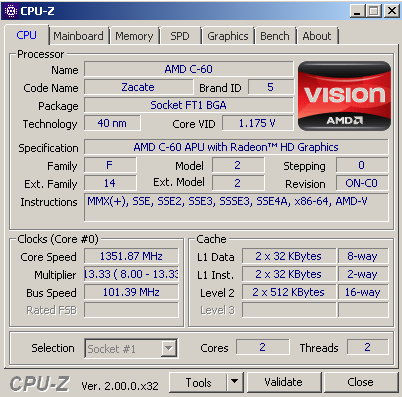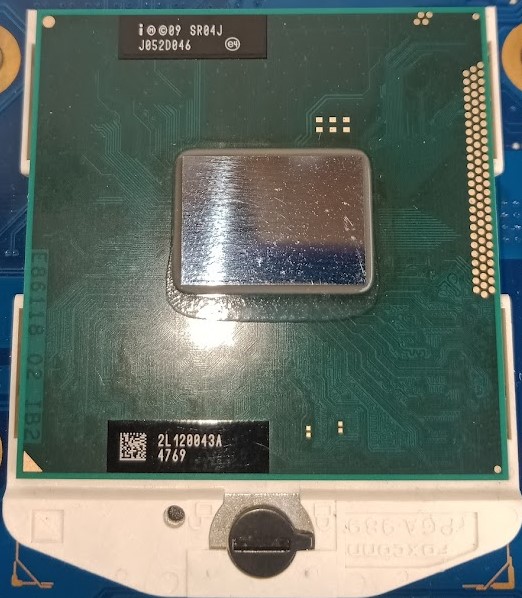Comparing: AMD C-60 vs Intel Core i3 2330M
In this comparison, we analyze two Processors: AMD C-60 and Intel Core i3 2330M, using synthetic benchmark tests to evaluate their overall performance. This side-by-side comparison helps users understand which hardware delivers better value, speed, and efficiency based on standardized testing. Whether you're building a new system or upgrading an existing one, this benchmark-driven evaluation offers valuable insights to guide your decision.
Specification Comparison Table
This specification comparison presents technical details of several devices or components to help you understand the key differences between each option. Use this table as a reference to determine which device best suits your needs.
| Specification | AMD C-60 | Intel Core i3 2330M |
|---|---|---|
| Architecture | x86 | x86 |
| Technology | 40 nm | 32 nm |
| Clock | 1 GHz - 1.3 GHz | 2.2 GHz - - |
| Core/Thread | 2 / 2 | 2 / 4 |
| Segmen | Mobile | Mobile |
Submission Comparison Table
This submission comparison table displays the number and details of benchmark data submissions from various devices or components. This information helps you understand the performance based on the benchmarks that have been tested, as well as providing an overview of the consistency and popularity of the available benchmark results.
| No. | Benchmark Software | AMD C-60 | Intel Core i3 2330M |
|---|---|---|---|
| 1 | PiFast |
2min, 14sec, 820ms |
34sec, 710ms |
| 2 | SuperPi - 1M |
1min, 139ms |
18sec, 143ms |
| 3 | SuperPi - 32M |
52min, 10sec, 800ms |
16min, 54sec, 925ms |
Submission Comparison Chart
This chart visualizes the benchmark scores comparison between two hardware devices based on submitted data.
Media Gallery
A collection of photos of tested hardware. These images can help you identify the physical form, model, and variant of the hardware in question. These photos are from our own documentation, and if they are not available we may not be able to document them.
About Hardware AMD C-60
Released in 2011, the AMD C-60 is a power-efficient processor from the Ontario series built on the Bobcat architecture. It has 2 cores and 2 threads, with a base speed of 1.0 GHz that can be increased to 1.33 GHz through Turbo Core technology. Designed specifically for portable devices such as netbooks and ultraportable laptops, the C-60 is focused on power efficiency and long battery life rather than high performance. With a TDP of just 9 watts, this processor enables ultra-thin and lightweight laptop designs without the need for complex active cooling systems. The main advantage of the C-60 is its extremely low power consumption, making it an attractive solution for users who need a lightweight computing device for daily activities with high mobility.
The AMD C-60 is also equipped with an integrated Radeon HD 6290 GPU, which has 80 shader cores and supports DirectX 11. Despite its modest specifications, this GPU is sufficient for multimedia purposes such as HD video playback, light graphics rendering, and old-school games with minimal graphics settings. However, overall, the performance of the AMD C-60 is limited and only suitable for light tasks such as browsing, typing documents, and using basic office applications. This processor will feel slow when used for heavy multitasking, modern software installation, or complex web-based applications. In tests using an Acer Aspire One 522 paired with 2GB DDR3 RAM and Windows 7 operating system, the processor was able to provide a decent user experience for basic needs, but was less responsive when compared to mainstream processors of the same generation. Even so, the AMD C-60 remains a viable solution for low-cost, power-efficient devices of its time.
Hardware Detail:
Device: Acer Aspire One 522
RAM: 2GB DDR3
OS: Windows 7
Friday, 08 April 2022 17:00:00 | Update: 1 month ago
About Hardware Intel Core i3 2330M
The Intel Core i3-2330M is a dual-core mobile processor launched in 2011 as part of Intel’s second-generation Sandy Bridge lineup. Designed for mid-range laptops, this processor features 2 cores and 4 threads thanks to Intel Hyper-Threading Technology, allowing it to handle light to moderate multitasking workloads efficiently. Operating at a fixed clock speed of 2.2 GHz and built on the 32nm process, the i3-2330M does not include Intel Turbo Boost, which limits its ability to dynamically increase performance under heavier loads, but it remains a solid choice for everyday use.
With a TDP of 35W, the i3-2330M balances power consumption and performance reasonably well for its era. It integrates Intel HD Graphics 3000, a GPU with a base clock of 650 MHz and a dynamic frequency up to 1.1 GHz. While not designed for modern gaming or demanding graphic applications, this integrated GPU handles HD video playback, basic 3D rendering, and older or lightweight games at low settings with relative ease. Users looking for casual computing and multimedia playback will find it sufficient.
In real-world usage, the Core i3-2330M performs well for standard computing tasks such as web browsing, streaming, office productivity (e.g., Word, Excel), and simple photo editing. Its Hyper-Threading capabilities give it a performance edge over older dual-core processors that lack thread duplication. However, the lack of Turbo Boost and a relatively low base frequency mean that it can struggle under CPU-intensive workloads like video rendering or large spreadsheet processing, especially when compared to more modern CPUs.
This specific configuration was tested on a SAMSUNG 300E4Z, a laptop originally shipped with an Intel Celeron B815 processor but later upgraded to the i3-2330M for better performance. With 4GB of DDR3 dual-channel memory and Windows 7 installed, the system runs smoothly for basic daily use, making the i3-2330M a practical upgrade option for budget-conscious users seeking improved performance without replacing their entire system.
Hardware Detail:
Device: SAMSUNG 300E4Z (This device originally used Celeron B815 which was upgraded to i3 2330M.)
RAM: 4GB DDR3 Dual Channel
OS: Windows 7
Friday, 05 February 2021 15:48:13 | Update: 1 month ago





